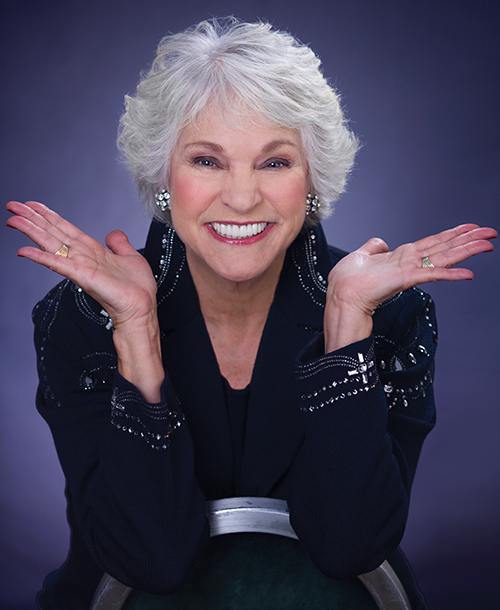Marta Sanders
Whatever Happened to That Nice Quaker Girl
Laurie Beechman Theatre, NYC, April 13, 15, 2022
Reviewed by Mary Bogue

A full hour before curtain the air in the Laurie Beechman Theatre was tangible and filled with electricity. The energy was palpable, hearts were beating quickly, and for many this was the first live cabaret show they’ve seen in over two years since Covid hit NYC. Something huge was imminent, and this was the calm before the storm! Then it hit: a gigantic tornado had indeed formed and suddenly touched down. That swirling vortex of cabaret, Marta Sanders, claimed all the attention, and a hush fell upon everyone gathered there. Sanders made her glamorous sequined and satin entrance, carrying her newly awarded Lifetime Achievement Award from the Manhattan Association of Cabarets (MAC), and so the theme of her lifetime achievements was set. It was evident that we would all witness why she is exceptional and why she won the prestigious award.
And so began Whatever Happened to That Nice Quaker Girl. Directed by her music director, pianist, and now storm-chaser extraordinaire, Mark Nadler, Sanders blew the roof off the club, one beam at a time. Nadler was a part of this ride of a lifetime, as he not only performed at the keys, but watched with sincere appreciation, marveling at this force of nature.
From the first note Sanders belted, she was fully in charge of her magnificent instrument. That set the show’s overall tone, and we sat awe-struck to listen to “Love Is in the Air” (John Paul Young) and Sanders, in her upbeat rendition, offered “there is a little bit of good in everyone.” With her disclosure of having been raised a fearless Quaker, she sang “This Little Light of Mine,” (Harry Dixon Lots). We learned about her truest self, the part that has a connection to “the light within.” Sanders outdid herself in belting “Sit Down, You’re Rockin’ the Boat” (Frank Loesser). Clearly, we are now in the eye of the storm, as she shared a delicate love letter to her family and then moves on to her awkward teen years. She was sweet and tender with “Christopher Robin Is Saying His Prayers” (H. Fraser-Simson). Of course, just when you’ve been lulled into this sweet and tender spot, the teenager still residing in Sanders rears her head and rebels with “The House of the Rising Sun.” All of this came from the nice Quaker girl who idolized Julie Andrews. She shared her Argentine mother’s Spanish version of Goldilocks, and her acting was totally sincere. In her beautiful Spanish, she romanced us with her mother’s favorite song, “El dia que me quieras” (Carlos Gardel), being sure to translate it into English with ease. We fall in love with her mother and Marta’s wide-eyed adoration of her family as well as her exposure to Latin living and loving in this absolutely gorgeous performance.
Can you imagine anyone bringing down the house, the house that has been swirling in time with her, with “Hernando’s Hideaway” (Jerry Ross/Richard Adler)? Yes, the house broke into raucous applause. She told of some darker, more tenuous times as a young woman who, because of her ability to translate English to Spanish, landed smack in the middle of an arms deal; met pat, her first serious boyfriend, and so very much more. She killed with “Forgive You” (Chip Orton/Doug James) and made us all fall in love with love and with her darling husband Gordon of 40 years. We were enchanted with “What Matters Most” (Alan & Marilyn Bergman/Dave Grusin), and she spun us into the circle within a circle, we whirled silently in space as Sanders drew us in. We could sense that the end was imminent, and we were suspended in mid-air. We had been picked up and hand-carried from the doldrums to an elusive place of happiness and then gently set down.
Doubts about the lights coming up and reality setting in were assuaged with her stunning “I’m Not Afraid” (Rod McKuen/Gerard Jouannest). People were touched, tears flowed, and broken hearts were healed. The energy built and suddenly we were on the other side of the twister and could breathe again. Witnessing Whatever Happened to that Nice Quaker Girl made us all want to sing along with her to “If They Could See Me Now” (Dorothy Fields/Cy Coleman):
“If they could see me now
That little gang of mine
I’m eatin’ fancy chow and drinkin’ fancy wine
I’d like those stumble bums
To see for a fact
The kind of top-drawer, first-rate chums I attract
All I can say is “Wow!”
Look-a where I am
Tonight, I landed, POW!
Right in a pot of jam
What a setup, holy cow!
They’d never believe it
If my friends could see me now!
With that, the audience jumped to its feet for a standing ovation, and with a deafening freight-train roar of applause, the category-five tornado that is Marta Sanders had stepped off the stage. The only destruction done here was to the illusion that a cabaret show couldn’t inspire, light up a stage, and make 80 minutes go by in a blink of an eye.
Thank you, Mark Nadler for directing this stellar show. Sanders deserves to have this program made into a televised one-woman show. Anyone needing a tumultuous makeover of spirit needs to experience her in such intimate quarters, to take her stories and songs into their heart and soul, and to be made whole. Well, we did “see her now,” and we’re longing for more. Finally, the tornado lifted, the lights came back on, and we were back on earth—just like that.
Marta returns the the Beechman July 14 and 17.





